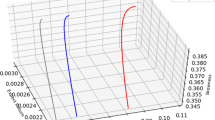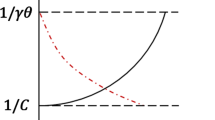Abstract
In the presence of uncertainty of asset returns, choosing an appropriate risk measure and determining the optimal weights of assets in a portfolio remain formidable and challenging problems. In this paper, we propose and study a mean-conditional value at risk-skewness portfolio optimization model based on the asymmetric Laplace distribution, which is suitable for describing the leptokurtosis, fat-tail, and skewness characteristics of financial assets. In addition, skewness is added into the portfolio optimization model to meet the diverse needs of investors. To solve this multi-objective problem, we suggest a simplified model with exactly the same solution. This modified model greatly reduces the complexity of the problem. Therefore, the mean-conditional value at risk-skewness model can be correspondingly solved. In order to illustrate the method, we provide an application concerning the portfolio allocation of 19 constituent stocks of S&P 500 index using our model. We show that this model could make important contributions to research on investment decision making.

Similar content being viewed by others
Notes
The top 20 constituents of S&P 500 by index weight in 2012 are: AAPL, XOM, CVX, MSFT, IBM, GE, JNJ, PFE, PG, INTC, PM, CSCO, GOOG, KO, WMT, ORCL, ABT, MRK, T, COP. However, historical prices for PM is incomplete (dated from March 17, 2008), so PM is excluded in our analysis.
References
Acerbi, C., & Tasche, D. (2002). Expected Shortfall: A natural coherent alternative to Value at Risk. Economic Notes, 31, 379–388.
Alexander, G. J., & Baptista, A. M. (2004). A comparison of VaR and CVaR constraints on portfolio selection with the mean-variance model. Management Science, 50, 1261–1273.
Arditti, F. D. (1967). Risk and the required return on equity. The Journal of Finance, 22, 19–36.
Arditti, F. D. (1971). Another look at mutual fund performance. Journal of Financial and Quantitative Analysis, 6, 909–912.
Artzner, P., Delbaen, F., Eber, J. M., & Heath, D. (1997). Thinking coherently: Generalised scenarios rather than VAR should be used when calculating regulatory capital. RISK-LONDON-RISK MAGAZINE LIMITED, 10, 68–71.
Behr, A., & Pötter, U. (2009). Alternatives to the normal model of stock returns: Gaussian mixture, generalised logF and generalised hyperbolic models. Annals of Finance, 5, 49–68.
Briec, W., Kerstens, K., & Jokung, O. (2007). Mean-variance-skewness portfolio performance gauging: A general shortage function and dual approach. Management Science, 53, 135–149.
Embrechts, P., Klppelberg, C., & Mikosch, T. (1997). Modelling extremal events for insurance and finance. New York: Springer.
Harlow, W. V., & Rao, R. K. S. (1989). Asset pricing in a generalized mean-lower partial moment framework: Theory and evidence. Journal of Financial and Quantitative Analysis, 24, 285–311.
Hogan, W. W., & Warren, J. M. (1974). Toward the development of an equilibrium capital-market model based on semivariance. Journal of Financial and Quantitative Analysis, 9, 1–11.
Jorion, P. (2000). Value at risk: The new benchmark for managing financial risk. New York: McGraw-Hill.
Konno, H., Shirakawa, H., & Yamazaki, H. (1993). A mean-absolute deviation-skewness portfolio optimization model. Annals of Operations Research, 45, 205–220.
Konno, H., & Suzuki, K. (1995). A mean-variance-skewness portfolio optimization model. Journal of the Operations Research Society of Japan, 38, 173–187.
Kotz, S., Kozubowski, T., & Podgorski, K. (2001). The Laplace Distribution and generalizations: A Revisit With applications to Communications, Exonomics, Engineering, and Finance (No. 183). Springer.
Kozubowski, T. J., & Podgórski, K. (2001). Asymmetric Laplace laws and modeling financial data. Mathematical and Computer Modelling, 34, 1003–1021.
Lu, Z., Huang, H. & Gerlach, R. (2010). Estimating value at risk: From JP Morgans standard-EWMA to skewed-EWMA forecasting. University of Sydney working paper .
Mandelbrot, B. (1963). The variation of certain speculative prices. The Journal of Business, 36, 394–419.
Mansini, R., Ogryczak, W., & Speranza, M. G. (2007). Conditional value at risk and related linear programming models for portfolio optimization. Annals of Operations Research, 152, 227–256.
Markowitz, H. (1952). Portfolio selection. The Journal of Finance, 7, 77–91.
Pflug, G. (2000). Some remarks on the value-at-risk and the conditional value-at-risk. In S. Uryasev (Ed.), Probabilistic constrained optimization: Methodology and applications. Dordrecht: Kluwer.
Rockafellar, R. T., & Uryasev, S. (2002). Conditional value-at-risk for general loss distributions. Journal of Banking & Finance, 26, 1443–1471.
Rockinger, M., & Jondeau, E. (2002). Entropy densities with an application to autoregressive conditional skewness and kurtosis. Journal of Econometrics, 106, 119–142.
Samuelson, P. A. (1970). The fundamental approximation theorem of portfolio analysis in terms of means, variances and higher moments. The Review of Economic Studies, 37, 537–542.
Yamai, Y., & Yoshiba, T. (2005). Value-at-risk versus expected shortfall: A practical perspective. Journal of Banking and Finance, 29, 997–1015.
Acknowledgments
The authors thank Professor XIAOJUN SHI and Doctor XIN JIANG for their helpful comments. We are also grateful for the anonymous reviewers’ constructive suggestions. This work is supported by the National Natural Science Foundation of China under Grants No. 71373017 and No. 71371022
Author information
Authors and Affiliations
Corresponding author
Rights and permissions
About this article
Cite this article
Zhao, S., Lu, Q., Han, L. et al. A mean-CVaR-skewness portfolio optimization model based on asymmetric Laplace distribution. Ann Oper Res 226, 727–739 (2015). https://doi.org/10.1007/s10479-014-1654-y
Published:
Issue Date:
DOI: https://doi.org/10.1007/s10479-014-1654-y




